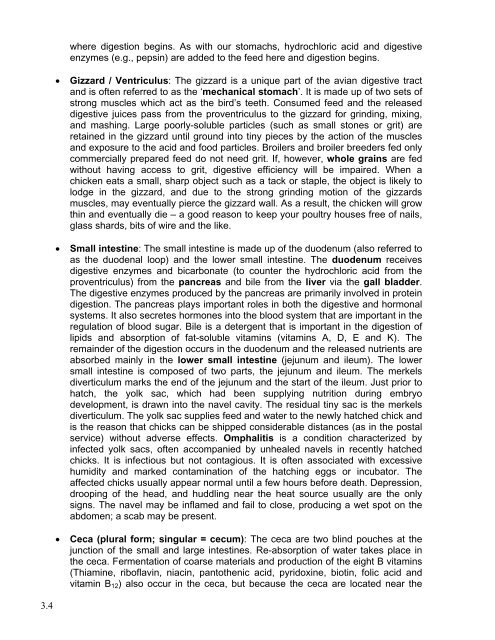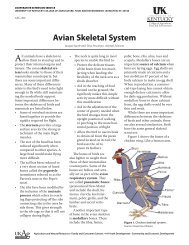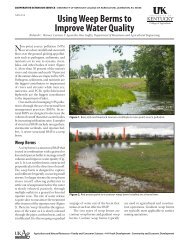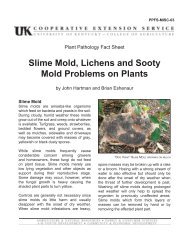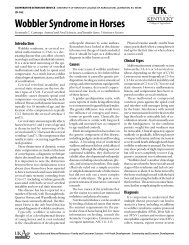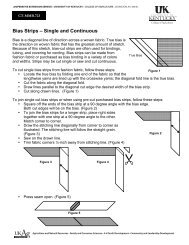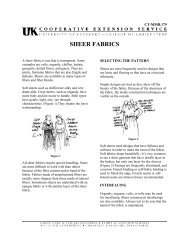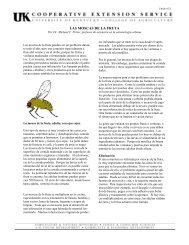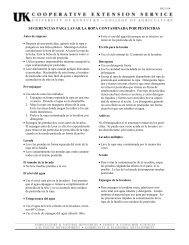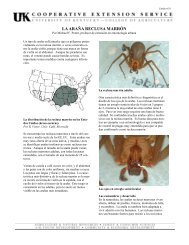Chapter 3 - CHICKEN ANATOMY AND PHYSIOLOGY
Chapter 3 - CHICKEN ANATOMY AND PHYSIOLOGY
Chapter 3 - CHICKEN ANATOMY AND PHYSIOLOGY
You also want an ePaper? Increase the reach of your titles
YUMPU automatically turns print PDFs into web optimized ePapers that Google loves.
3.4<br />
where digestion begins. As with our stomachs, hydrochloric acid and digestive<br />
enzymes (e.g., pepsin) are added to the feed here and digestion begins.<br />
• Gizzard / Ventriculus: The gizzard is a unique part of the avian digestive tract<br />
and is often referred to as the ‘mechanical stomach’. It is made up of two sets of<br />
strong muscles which act as the bird’s teeth. Consumed feed and the released<br />
digestive juices pass from the proventriculus to the gizzard for grinding, mixing,<br />
and mashing. Large poorly-soluble particles (such as small stones or grit) are<br />
retained in the gizzard until ground into tiny pieces by the action of the muscles<br />
and exposure to the acid and food particles. Broilers and broiler breeders fed only<br />
commercially prepared feed do not need grit. If, however, whole grains are fed<br />
without having access to grit, digestive efficiency will be impaired. When a<br />
chicken eats a small, sharp object such as a tack or staple, the object is likely to<br />
lodge in the gizzard, and due to the strong grinding motion of the gizzards<br />
muscles, may eventually pierce the gizzard wall. As a result, the chicken will grow<br />
thin and eventually die – a good reason to keep your poultry houses free of nails,<br />
glass shards, bits of wire and the like.<br />
• Small intestine: The small intestine is made up of the duodenum (also referred to<br />
as the duodenal loop) and the lower small intestine. The duodenum receives<br />
digestive enzymes and bicarbonate (to counter the hydrochloric acid from the<br />
proventriculus) from the pancreas and bile from the liver via the gall bladder.<br />
The digestive enzymes produced by the pancreas are primarily involved in protein<br />
digestion. The pancreas plays important roles in both the digestive and hormonal<br />
systems. It also secretes hormones into the blood system that are important in the<br />
regulation of blood sugar. Bile is a detergent that is important in the digestion of<br />
lipids and absorption of fat-soluble vitamins (vitamins A, D, E and K). The<br />
remainder of the digestion occurs in the duodenum and the released nutrients are<br />
absorbed mainly in the lower small intestine (jejunum and ileum). The lower<br />
small intestine is composed of two parts, the jejunum and ileum. The merkels<br />
diverticulum marks the end of the jejunum and the start of the ileum. Just prior to<br />
hatch, the yolk sac, which had been supplying nutrition during embryo<br />
development, is drawn into the navel cavity. The residual tiny sac is the merkels<br />
diverticulum. The yolk sac supplies feed and water to the newly hatched chick and<br />
is the reason that chicks can be shipped considerable distances (as in the postal<br />
service) without adverse effects. Omphalitis is a condition characterized by<br />
infected yolk sacs, often accompanied by unhealed navels in recently hatched<br />
chicks. It is infectious but not contagious. It is often associated with excessive<br />
humidity and marked contamination of the hatching eggs or incubator. The<br />
affected chicks usually appear normal until a few hours before death. Depression,<br />
drooping of the head, and huddling near the heat source usually are the only<br />
signs. The navel may be inflamed and fail to close, producing a wet spot on the<br />
abdomen; a scab may be present.<br />
• Ceca (plural form; singular = cecum): The ceca are two blind pouches at the<br />
junction of the small and large intestines. Re-absorption of water takes place in<br />
the ceca. Fermentation of coarse materials and production of the eight B vitamins<br />
(Thiamine, riboflavin, niacin, pantothenic acid, pyridoxine, biotin, folic acid and<br />
vitamin B12) also occur in the ceca, but because the ceca are located near the


